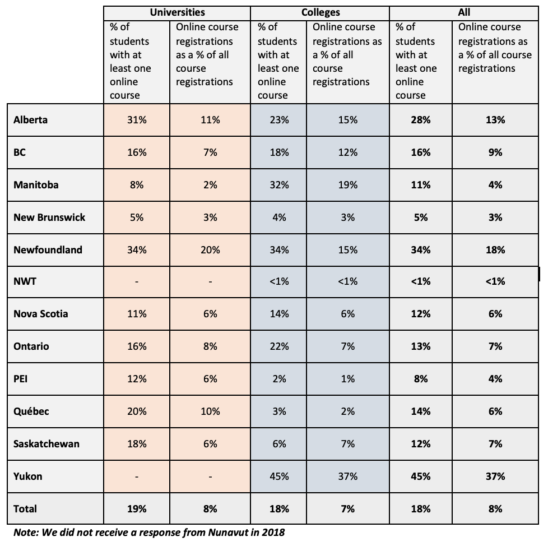 Northern Lakes College, Alberta, has one of the highest proportions of online students in Canada
Northern Lakes College, Alberta, has one of the highest proportions of online students in CanadaThe story so far
In earlier posts about the Canadian Digital Learning Research Association’s latest 2018 survey of online learning in Canadian post-secondary institutions, I reported that in the academic year 2016-2017:
- 1 in 5 students in Canadian post-secondary institutions took at least one online course for credit
- 8% of all credit course enrolments are in online courses
- the average course load for online students is three to four courses a year
- overall course loads range from 7-8 course a year in universities to around 10 courses a year in colleges
- the 1.36 million online course registrations in 2016-2017 are the equivalent of 4 universities of 27,000 students each, 4 colleges of 12,000 students each, and 1 CEGEP of 3,500 students
The Canadian Digital Learning Research Association (CDLRA) has also published four regional reports. I have already written about the Western Canada report, and the Arctic/Far North report. I will write shortly about the Ontario and Québec reports.
The plot thickens
Although what follows is all in the survey’s full technical report, CDLRA has also pulled out some specific data, which give a more detailed view of online learning in Canada (all named institutions have given permission to be identified):
Distance teaching institutions
The following are fully distance institutions and by definition have 100% fully distance students, which these days also means nearly all online:
- Athabasca University, Alberta
- Téluq, Québec
- Cégep à distance, Collège de Rosemont, Québec
- Collège Educacentre, British Columbia
Dual mode institutions with a high proportion of online registrations
However, some campus-based institutions also have high percentages of fully online course registrations, as follows:
- Northern Lakes College, Alberta (58%)
- BCIT, British Columbia (42%)
- Université Ste.-Anne, Nova Scotia (41%)
- Yukon College (37%)
- Royal Roads University, British Columbia (35%)
Institutions with large numbers of online registrations
The following institutions have large numbers of online course registrations:
Universities:
- Athabasca University: 80,668
- Université Laval, Québec: 74,229
- Téluq: 44,213
- University of Waterloo, Ontario: 43,572
- Concordia University, Québec: 32,401
Colleges/CEGEPs:
- Algonquin College, Ontario: 29,600
- Fanshawe College, Ontario: 28,612
- Centennial College, Ontario: 22,528
- British Columbia Institute of Technology: 20,492
Provincial differences
The following table shows the differences between provinces by type of institution in terms of (a) the proportion of students taking at least one online course (b) the proportion of course registrations that are in online courses:

It can be seen that the Yukon has the highest proportion of students taking at least one online course (45%) followed by Newfoundland (34%), while the two Arctic territories of Nunavut and NWT (<1%) and New Brunswick (5%) have the least.
However, a better measure of the extent of online learning is the proportion of course registrations in online courses. In the Yukon, more than a third of all course registrations (37%) are in online courses, and in Newfoundland the figure is 18%. As well as the two Arctic territories (<1%), and New Brunswick (3%), Manitoba (4%) and PEI (4%) have a low proportion of online course registrations.
However, in terms of sheer numbers, Ontario has by far the largest number of online course registrations (reflecting the size of its population overall, which is 39% of the Canadian population):
- Ontario: 550,203 (41% of all Canadian post-secondary online course registrations)
- Québec: 303,347 (23%)
- British Columbia: 193,061 (14%)
- Alberta: 189,492 (14%)
Denouement
We now know who the main providers of online and distance education are in Canada in 2016-2017. The universities of Athabasca and Laval, and Algonquin and Fanshawe colleges, and the province of Ontario, are the clear leaders in terms of overall online course registrations.
However, the provinces of Yukon and Newfoundland are leaders in the proportion of course registrations that are online, and Northern Lakes College, Alberta; BCIT, British Columbia; and Université Ste.-Anne, Nova Scotia, have the highest proportion of online students amongst campus-based institutions.
However, there is no particular virtue in having lots of online courses. The survey merely measures participation rates. What matters more is the relevance and quality of the online provision and the extent to which the online courses meet student needs. Nevertheless, with an average of approximately 8% of all course registrations being in online courses, there still appears to be considerable room for growth in online learning for most Canadian post-secondary institutions.









 Dr. Tony Bates is the author of eleven books in the field of online learning and distance education. He has provided consulting services specializing in training in the planning and management of online learning and distance education, working with over 40 organizations in 25 countries. Tony is a Research Associate with Contact North | Contact Nord, Ontario’s Distance Education & Training Network.
Dr. Tony Bates is the author of eleven books in the field of online learning and distance education. He has provided consulting services specializing in training in the planning and management of online learning and distance education, working with over 40 organizations in 25 countries. Tony is a Research Associate with Contact North | Contact Nord, Ontario’s Distance Education & Training Network.

